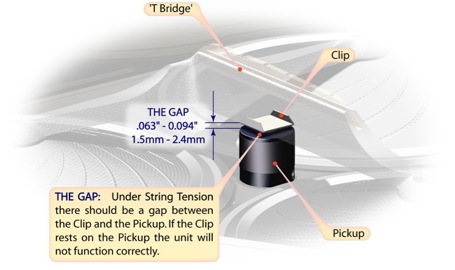
The Magnophonic Pickup
Designed Specifically for Tricone Resonator Guitars
![]()
About the Magnophonic Pickup
With the installation of three simple parts (pickup, clip and preamp) the Tricone becomes its own microphone.

The pickup is easily mounted in the center of the pan using the existing 'pan screw hole' and the hardware that is supplied with the pickup. The clip slides onto the ‘T Bridge’ and locks firmly in place over the pickup with a gap between them as indicated above. The gap must be measured under string tension. The clip acts as a light-weight ‘Diaphragm’, any movement of the ‘T Bridge’ vibrates the clip/diaphragm, which in turn generates an electronic signal in the Pickup.
The Pickup signal is amplified by the Preamplifier to bring it up to ‘regular guitar level’.
The movement of the ‘T Bridge’ is very complex, a product of the combined vibration of the three cones, string vibration and various other factors, it is at the very heart of the Tricone sound. The Magnophonic pickup captures the complex subtlety of the ‘T Bridges’ movement, accurately reproducing the Tricone’s sound.
Magnophonic Pickup Specifications:
Frequency Response: 20Hz - > 200KHz
Nominal Output Level: -22dB
Nominal Impedance: Low: 5.2K ± 5%
Diameter: 0.8" (20.3mm)
Height: 0.68" (17.1mm)
About the iP Preamplifier
Highlanders true 'Class A' preamplifier is the result of more than 30 years of experience and research in professional live sound and recording studio audio. The preamp's exceptionally low noise and distortion coupled with it's wide frequency response and dynamic range set new standards for musical instrument amplification.
The preamplifier is housed in a unique package that is as rugged as it is elegant and functional. The electronics are protected from mechanical shock and humidity by a special potting compound. The tubular metal housing protects the preamplifier from interference. In a typical acoustic guitar installation, no soldering is required. The screw thread used to hold the preamp in the end block of a guitar is designed to minimize the possibility of the preamp coming loose as the end block changes size with variations in humidity and temperature.
The use of an advanced discrete design (there are no ‘off the shelve’ audio chips in the preamp) not only provides great audio performance, it means the preamp can be optimized for low power consumption. Powered by a single 9V battery, the preamp draws 440µA from the battery and activates only when you plug in. Battery life is approximately 1000 hours. (You should notice a loss of highs when the battery is is almost run down, leaving you a few hours to change the battery before it dies).
In this day and age with the great strides forward in low noise amplification and digital recording systems, noise and distortion from your guitar preamp will become more and more evident. Highlander sets new standards for low noise and low distortion electronics, keeping you “up to date” with new technology for years to come.
iP Preamplifier Specifications:
Frequency Response: Flat from 10Hz to >500KHz
Dynamic Range: >100dB (ref. 10Hz to 40KHz)
Input Impedance: Matched to Pickup
Output Impedance: <80ohms
nominal output level: -10db
headroom: 18db (ref. -10db)
power consumption: 440uA
power: one 9v battery
battery life: iP-1 > 1000 hours; iP-2 and Internal Mic > 500 hour
(Measurements made with a test load of 100Kohms)
About Power for the INLINE Preamp
The Highlander iP-1 Preamp runs from a single 9V battery.
The External Power Option
The INLINE Preamp Can be wired to accept power via the ring connection in the ¼" stereo jack. The battery connector and battery are housed in a box that sits on the floor. A stereo cable connects the guitar to the box, carrying the audio, power and ground.
The power is turned on when the guitar is connected to the External Power Box with a stereo guitar cable.
The power is turned off when the guitar is disconnected.
Battery life is approximately 1000 hours for a preamp. Unplugging the guitar when its not being played optimizes battery life. If the guitar is plugged in for 2 to 8 hours every day, 7 days a week, the battery will last approximately two to six months. There are many variables that have an effect on battery life. For example: the type of battery, the age of the battery when purchased and temperature.
If the sound becomes dull (loses high end) then it's time to change the battery.